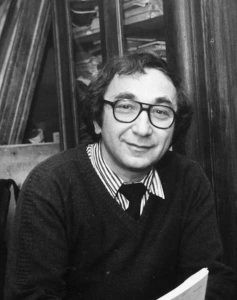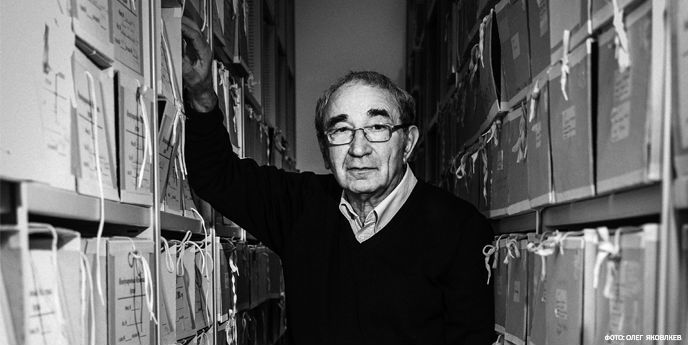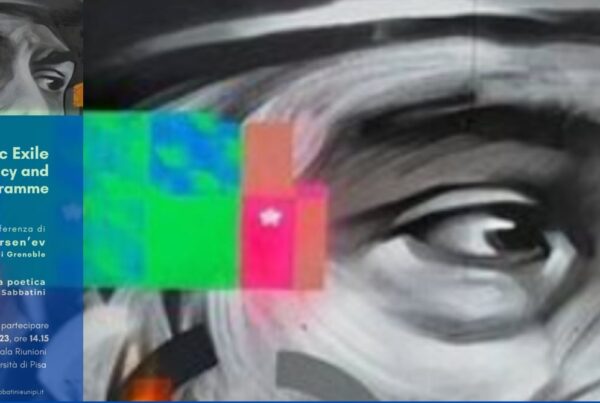Vel’sk, 1946–Tel Aviv, 2017

Arsenii Roginskii, © Prava cheloveka v Rossii – Arkhiv materialov.
Arsenii Borisovich Roginskii was born on 30th March 1946 in the town of Vel’sk, in the province of Arkhangelsk, where his Jewish father, an engineer, had been exiled after his arrest in Leningrad in 1938 during the Great Terror. He was arrested again in 1951 and afterwards died in a labour camp. In 1956 the family was allowed to return to Leningrad, and in 1962 Roginskii was admitted to the school of the famous semiologist Iurii Lotman at the University of Tartu, where he met figures such as Gabriel Superfin who later became important representatives of dissent. It was in Tartu that Roginskii began studying 19th century opposition movements including the Decabrists and the Populists. After he finished university, he worked as a bibliographer at the National Library of Leningrad and then as a teacher of Russian language and literature at an evening school.
For the following ten years, despite extreme difficulties in gaining access to State archives, Roginskii continued his historical research, often documenting lives and episodes that would otherwise have remained unknown.
He was deeply aware of the need to recover and preserve historical evidence about the the USSR and especially the Great Terror and his search for material led him to frequent other young scholars in Leningrad such as Aleksandr Dobkin and Sergei Dediulin who also had a suspicion of official historiography. The position of Roginskii and his contemporaries can be regarded as a continuation of the work of the dissident historians of the 1960s, such as Roy Medvedev, Petr Grigorenko and Mark Popovskii, although Roginskii, went further than his predecessors in insisting that historical research be grounded in a scientific basis. This belief in the importance of scientific documentation led Roginskii to meet many of the leading voices of dissent, such as the poet Natal’ia Gorbanevskaia, who at the time was collecting materials for the “Chronicle of current events“, the samizdat periodical founded in 1968 to record acts of repression and violations of human rights.
At the beginning of the Seventies, Roginskii established contacts with several Moscow intellectuals including Larisa Bogoraz and the historian Mikhail Gefter which led to the founding of the historical collection “Pamiat‘” (Memory), published from 1976 to 1982. Pamiat became a cornerstone for independent historiography, combining the recording of memories with in-depth research. In the preface to the first edition, the editors state that they “consider it their duty to save from oblivion all the historical facts and names condemned to disappear, especially the names of those who were killed, persecuted, and slandered; the names of families who were annihilated; and also the names of their executioners” as “the most important thing is to recover the historical facts and disseminate them with scientific instruments”. The magazine’s contributors remained anonymous, but this did not prevent Roginskii being investigated by the KGB and subsequently fired from his teaching job. To avoid being charged with vagrancy, he was hired as secretary by Professor Iakov Lur’e, who, as a consequence, was forced to take early retirement. In 1981, after refusing to emigrate, Roginskii’s permission to access the library was revoked and he was finally arrested under suspicion of falsifying a letter authorising him to work in the archive. He refused to give any explanation about the letter, stating that the practice of restricting access to historical documents was inappropriate, a view he expressed again in his last speech in court.
Although, several writers (including Veniamin Kaverin and Evgenii Evtushenko), historians and other intellectuals, spoke in his defense, Roginskii was sentenced to four years imprisonment. He served the full sentence in labour camps, refusing to accept a transfer to be detained with other political prisoners or reveal the names of the other contributors to the editorial project of “Pamiat’“.
After leaving the concentration camps in 1985, Roginskii became a forceful advocate for shedding light on the crimes of Stalin’s regime and restoring dignity to the millions of Soviet victims of repression.
From 1986 to 1989 a series of studies begun before he was arrested were published anonymously in the almanac Minuvshee, and he contributed to the volume Memoirs of Peasant Tolstoyans in Soviet Russia in 1989 and to the almanac Zven’ia from 1990 to 1992. He was also a member of the editorial boards of the magazines “Zvezda” and “Otkrytaia politika”.
In 1989 he was one of the founders of the independent association “Memorial”, and was subsequently elected president of “Memorial International”. He was an extremely active member of the association, helping to build a network of peripheral offices in Russia and in many European countries.
In 1990, together with Nikita Okhotin, he inaugurated the Center of Science and Education. From 1990 to 1993 he participated as an expert in the work of government commissions for human rights, for the passage of the archives of the CPSU and the KGB to Russian state control and for the rehabilitation of the victims of political repression.
Roginskii’s contribution to Russian historiography through his work with “Memorial” was immense and included the creation of a huge database of material, the publication of several works and the inauguration of the competition “The Individual in History: Russia, 20th century”, based on family or local documents and memories and implemented in collaboration with a large number of Russian schools.
Until the end of his life he promoted and participated in the monitoring of human rights violations in the Caucasus regions, maintaining contacts with the Helsinki Group, the European Court of Human Rights and the Lev Kopelev Foundation; he received several international prizes.
Elda Garetto
[31st December 2022]
Bibliography
- Drauschke F., Kaminsky A., Roginskij A., Erschossen in Moskau …: Die deutschen Opfer des Stalinismus auf dem Moskauer Friedhof Donskoje 1950–1953, Metropol’ Verlag, Berlin 2008.
- Eremina L., Roginskii A. (eds.), Rasstrel’nye spiski Moskva, 1937-1941: “Kommunarka”, Butovo: kniga pamiati zhertv politicheskikh repressii, Memorial, Moskva 2000.
- Eremina L., Roginskii A. (eds.), Rasstrel’nye spiski. Moskva, 1935-1953: Donskoe kladbishche (Donskoi krematorii): kniga pamiati zhertv politicheskikh repressii, Memorial, Moskva 2005.
- Okhotin N., Roginskii A., O mashtabe politicheskikh repressii v SSSR: 1921-1953, 2005, http://www.osa.ceu.hu/updates/2005/publications/terrorstatsru.htm, online (last accessed: 31/12/2022).
- Roginskii A., Gromova T., Vospominaniia krest’ian-tolstovtsev. 1910–1930 gody, Kniga, Moskva 1989; eng. transl.: Edgerton W., Memoirs of Peasant Tolstoyans in Soviet Russia, Indiana University Press, Bloomington 1993.
- Roginskij A., “Nach der Verurteilung”. Stalins letzte Opfer: verschleppte und erschossene Österreicher 1950–1953, Böhlau Verlag, Wien 2009: 97–140.
- Roginskii A., Izbrannye stat’i, vystupleniia, kommentarii k nauchnym publikatsiiam, interv’iu. “Zven’ia”, Moskva 2016: 41-59.
- Roginskii A., La chose la plus monstrueuse était l’absence de couleurs, “Cahiers du monde russe”, 2/3 (2018): 369-390.
Sitography
- Arseny Roginsky, Russian Human Rights Leader, is dead at 71, “The New York Times”, 23.12 (2017), https://www.nytimes.com/2017/12/23/obituaries/arseny-roginsky-russian-human-rights-leader-is-dead-at-71.html, online (last accessed: 31/12/2022).
- Memorial, Arsenii Roginskii in memoriam, https://www.memo.ru/ru-ru/memorial/departments/intermemorial/news/102, online (last accessed: 31/12/2022).
- The Historical Truth-telling of Arseny Roginsky, “The New Yorker”, 19.12 (2017), https://www.newyorker.com/news/postscript/the-historical-truth-telling-of-arseny-roginsky, online (last accessed: 31/12/2022).
Filmography
- The right to memory, documentary film directed by Ludmila Gordon, 2018, https://therighttomemoryfilm.com/, online (last accessed: 31/12/2022).
To cite this article:
Elda Garetto, Arsenii Roginskii, in Voci libere in URSS. Letteratura, pensiero, arti indipendenti in Unione Sovietica e gli echi in Occidente (1953-1991), a cura di C. Pieralli, M. Sabbatini, Firenze University Press, Firenze 2021-, <vocilibereurss.fupress.net>.
eISBN 978-88-5518-463-2
© 2021 Author(s)
Content license: CC BY 4.0





